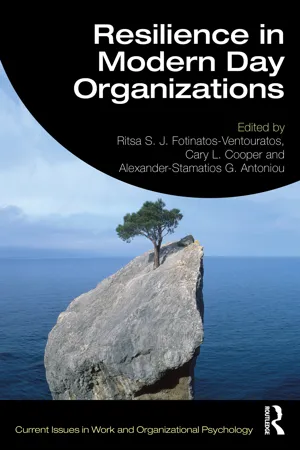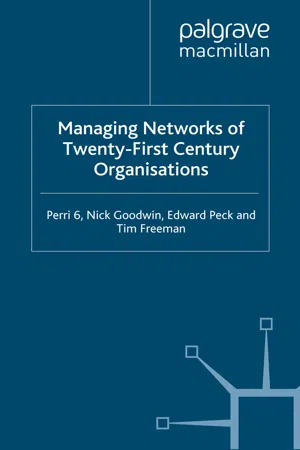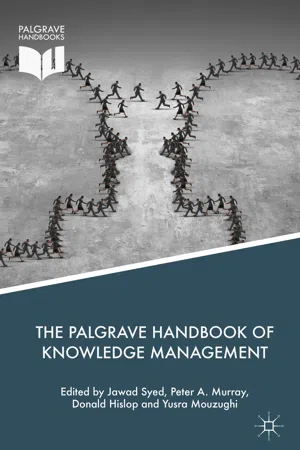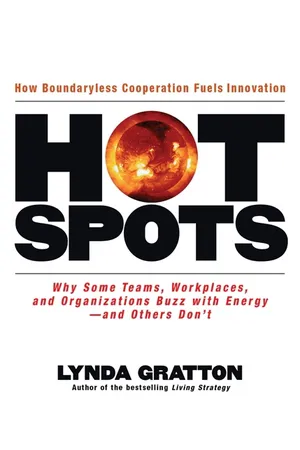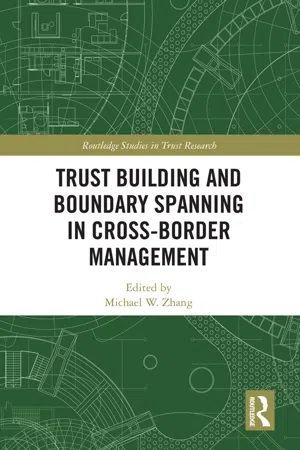Business
Boundary Spanning
Boundary spanning refers to the process of connecting and collaborating across different organizational boundaries, such as departments, teams, or external partners. It involves building relationships, sharing information, and coordinating activities to achieve common goals. Effective boundary spanning is crucial for fostering innovation, problem-solving, and creating synergies between different parts of an organization.
Written by Perlego with AI-assistance
Related key terms
1 of 5
11 Key excerpts on "Boundary Spanning"
- eBook - PDF
The Blackwell Handbook of Global Management
A Guide to Managing Complexity
- Henry W. Lane, Martha L. Maznevski, Mark E. Mendenhall, Jeanne McNett, Henry W. Lane, Martha L. Maznevski, Mark E. Mendenhall, Jeanne McNett(Authors)
- 2009(Publication Date)
- Wiley-Blackwell(Publisher)
Effective Boundary Spanning is the process through which the global manager gains all this information. Boundary Spanning: An evolving perspective We find the traditional, linkage approach to Boundary Spanning too static in its imagery to capture the essence of the vitality Mørk fostered at SAS. Knowing who 8 was not enough for the SAS boundary spanners. Mørk focused on the information flows between and among the “ whos .” The way of thinking he introduced led to establishing a process, rather than simply a structure, which in turn led to a focus on the flow of information rather than the architecture of the information network. As described above, the traditional terminology to capture the idea of Boundary Spanning has been built on the idea of linkage , the underlying metaphor being links in a chain. This conceptual framework is somewhat limited in its ability to capture and describe the capabilities managers need to be successful in a global environment. Man-agers find themselves in the midst of a dynamic complexity in which structured and formalized linkages may actually impede Boundary Spanning. Given such complexity, Boundary Spanning 125 TABLE 7.1 Boundary Spanning Traditional, structure-based concept New, process-based concept Linkages as in a chain; connections Conduit, flows Structural aspects received focus Container, content and flow are the focus Static Dynamic Straddling boundaries Joining knowledge flows Gateway and gatekeepers Knowledge flows among people, flow rates; information brokers Relationships Use of relationships global organizations need to look beyond the rigid, traditional boundaries that separate employees, tasks, processes, and places. We suggest thinking of Boundary Spanning in a more fluid, evolving way, as the conduits or piping system and the information that flows through them. - eBook - ePub
- Nanny Bressers, Jurian Edelenbos(Authors)
- 2016(Publication Date)
- Routledge(Publisher)
Scholten (2009) highlights a claim to expertise, ability to manage complexities and interdependencies, influencing and negotiation capabilities and networking skills, and adds persistence. While entrepreneurship highlights innovation and change, Boundary Spanning is process-focused and collaborative.While subscribing to the general ideas that charismatic individuals with bright ideas, connective capacity and a sense of timing can make a difference, the present chapter does not make heroic claims that Boundary Spanning makes revolutions, transitions and/or paradigm shifts, but maintains that in a complex adaptive environment such as the Dutch water sector (Geldof 1995), Boundary Spanning may have almost become a system requirement in which mono-sectoral approaches are becoming obsolete. The degree and the timing of spanning, however, are of crucial importance.Spanning which Boundaries?
Boundaries protect a system from its environment to maintain safety. They create buffers to maintain safety (Ernst and Chrobot-Mason 2010 ). They result from decisions or judgments, made by a decision-maker, analyst, scientist or practitioner. As boundaries may be unclear and fluid, boundary judgments are needed. Boundary judgments concern issues such as: what is your task, your domain? These boundaries may be highly institutionalized, such as national sovereignty. ‘Boundary objects’ such as transboundary infrastructure, however, can incite actors to reconsider their boundaries, but also become a bone of contention. Rivers are such objects – shared by several different communities that are viewed or used differently by each of them (Jarvis et al. 2010 ).Boundary Spanning rarely comes naturally and requires risk-taking and strategy to persuade others in the field. This requires political, intellectual and/or structural leadership (Young 1991 - eBook - ePub
- Ritsa S. J. Fotinatos-Ventouratos, Cary L. Cooper, Alexander-Stamatios G. Antoniou, Ritsa S. J. Fotinatos-Ventouratos, Cary L. Cooper, Alexander-Stamatios G. Antoniou(Authors)
- 2023(Publication Date)
- Routledge(Publisher)
van den Adel et al., 2023 ).Purpose of Boundary Spanning
Our final dimension of Boundary Spanning configurations considers the purpose of teams’ external interactions. Research suggests that Boundary Spanning can serve the purpose of coordinating work, representing team interests, and scouting external information and knowhow (Ancona & Caldwell, 1992 ; de Vries et al., 2014 ). Of these purposes, coordination activities represent the most intense form of Boundary Spanning. It requires members from different teams to discuss and agree on who will do what at what point in time, in order to avoid duplicate, redundant, or conflicting responses to disruptions. Coordination types of Boundary Spanning are by nature reciprocal. Only when teams’ members engage in active discussions and joint decision-making will they be able to align the content and schedules of their activities when dealing with a disruption. As such, this type of Boundary Spanning is labour-intensive in terms of required investment of time and effort. Members from different teams will need to be deeply acquainted with each other’s working methods, goals, and activities to engage in meaningful coordinative Boundary Spanning. At the same time, the intensity and reciprocity of coordinative Boundary Spanning enables exchange of rich information and it can motivate active support and assistance from outside team members (de Vries et al., 2014 , 2016 , 2022a ).Teams’ Boundary Spanning may also serve the purpose of representing and connecting the team to higher-level management (ambassadorial activities). This type of Boundary Spanning emerges mostly between members of different hierarchical layers within the same organization (e.g., between lower-level team members or leaders and higher-level executives; Ancona & Caldwell, 1992 ; Marrone, 2010 - P. Perri, N. Goodwin, E. Peck, T. Freeman(Authors)
- 2016(Publication Date)
- Palgrave Macmillan(Publisher)
There is a strand of strategic management research that has examined the importance of Boundary Spanning units or agencies that are located at the periphery of large organisations and shown that their local decisions are often critical in shaping the strategy of the whole (e.g. Regnér, 2000). Certain types of role are often defined within organisations as dedicated to Boundary Spanning, such as account management (Birkinshaw et al., 2000) or procure- ment management. Then there are specialists in Boundary Spanning who are not attached by direct organisational accountability (such as employment by a single client) to a member of the network across which they supply connecting services and who are not just members of the network like the others because they are involved in, for example, upstream vertical supply to the rest of the network of a crucial resource or, in the pure case, in supplying nothing but access to social ties. Thompson GF (2003) points out that studies on certain sub-types of venture capital firm, business angels and business introduction services seem to be of this type. In much of the more recent literature, however, boundary spanners are defined as individuals rather than units, whose social networks – whether informally arranged and conducted or specifically sanctioned in their autho- rised roles – are important to the management of inter-organisational relations. Those who take a personalistic view of inter-organisational net- works hypothesise that organisational linkages are embedded in personal social networks (Granovetter, 1985), while institutionalists tend to predict the reverse direction of causation. Examples from commercial organisations would include account managers who are responsible for managing downstream vertical ties with customers and purchasing and procurement managers charged with handling upstream vertical ties along the supply chain (Katz and Kahn, 1966).- eBook - ePub
User Integration in Sustainable Product Development
Organisational Learning through Boundary-Spanning Processes
- Esther Hoffmann(Author)
- 2017(Publication Date)
- Routledge(Publisher)
15 exist inside an organisation, inhibiting cooperation between different departments and causing serious difficulties in product development processes. The varying thought worlds result in a fragmented view of products and markets. Different departments develop a shared system of meaning, and ideas that do not fit may be reconfigured or rejected outright (Dougherty 1992). The idea of different thought worlds can be transferred to the organisational boundary: internal and external thought worlds may be even more divergent than thought worlds within an organisation. Dougherty (1992) concludes that innovation calls for collective action and for efforts to create shared understandings from varying perspectives; a precondition for collective action is that interactions between thought worlds are based on appreciation and joint development. Transferred to the external organisational boundary, a need for boundary-spanning interaction that is based on mutual acceptance and trust (see Lorenz 2003) can be assumed to be an appropriate means of acquiring and interpreting relevant knowledge. Additionally, it is essential that different departments are involved in the process in order to avoid internal knowledge losses due to communication problems between different departments and their respective thought worlds.Close and extensive relationships with customers, suppliers and other key stakeholders are important in order to get access to external knowledge and to trigger organisational learning (Slater and Narver 1995). Product development processes are mostly confronted with heterogeneous and dynamic task environments. In these conditions boundary-spanning units are differentiated functionally to correspond to different segments (Thompson 1967). It can thus be supposed that a company develops special boundary-spanning processes within the product development unit. Different external knowledge sources such as research institutes and universities, competitors, suppliers, customers and users or user communities are relevant for product development. Boundary Spanning in product development may, for example, be accomplished through research cooperation, dialogue processes or market research.It is crucial that companies get information about consumer wants and needs. This could be achieved through boundary-spanning activities involving members of the company as well as current and potential users of their products. Pitta and Franzak (1996: 72) recommend cross-functional teams that additionally involve consumers in order to reduce misunderstandings that arise in the different values found inside and outside the organisation. On the same grounds, these boundary-spanning teams can identify early in the process problem areas that need to be dealt with (Pitta and Franzak 1996). With regard to the involvement of users in product development processes, the outside-in and inside-in activities are more relevant than the inside-out processes. Thus, scanning and filtering as well as mapping, buffering and spreading are especially important issues. These have to be linked to organisational learning processes. Slater and Narver (1995) describe organisational learning as being valuable to a firm’s customers because it focuses on understanding and satisfying their expressed and latent needs through new products and services. A company’s market orientation is based on organisational learning since companies need to acquire and generate knowledge about current and future customer needs, disseminate it across departments and respond to this knowledge in the form of products or services (see Kohli and Jaworski 1990: 6). - eBook - ePub
- Jawad Syed, Peter A. Murray, Donald Hislop, Yusra Mouzughi, Jawad Syed, Peter A. Murray, Donald Hislop, Yusra Mouzughi(Authors)
- 2018(Publication Date)
- Palgrave Macmillan(Publisher)
Part II Knowledge Management and Boundary SpanningPassage contains an image
© The Author(s) 2018Begin AbstractThe Palgrave Handbook of Knowledge Management https://doi.org/10.1007/978-3-319-71434-9_14Jawad Syed ,Peter A. Murray ,Donald Hislop andYusra Mouzughi (eds.)14. A Conceptual Perspective on Knowledge Management and Boundary Spanning: Knowledge, Boundaries and Commons
End AbstractLéo Joubert 1 andClaude Paraponaris1(1) Aix Marseille Univ, CNRS, LEST, Aix-en-Provence, FranceClaude ParaponarisBoundaries and transcending boundaries have become a major discussion topic in fields involved in the creation of value in western economies. Quite often assimilated into physical and cultural limits, boundaries are presented as obstacles to entrepreneurial achievement. This entrepreneurial ability is one that unfolds in different fields—the economy, of course, but also cultural activities, notably through a revolution of usages facilitated by internet business platforms. It seems pertinent to compare how commercial and non-commercial activities process information and accumulate knowledge.Boundaries must be crossed in order to diffuse knowledge and create innovation . But boundaries also act as a protection for scientific, technical and cultural organisations and institutions. Boundaries are multiple and, in principle, objective between projects, organisations, types of knowledge, scientific disciplines and, of course, between the various actors. But are they really all that objective?The succession of approaches towards knowledge management has a history (Snowden 2002 ). A genealogy of the concepts and their success is available, testifying to the plasticity of knowledge boundaries. In this sense, our analysis presents boundaries as a construct that enables association between elements as much as separation.We begin by presenting a genealogy of the major concepts in the field of knowledge dissemination. We lay down the various terms that refer to knowledge boundaries, insisting, in particular, on the persistent misunderstanding about how the learning - eBook - ePub
Hot Spots
Why Some Teams, Workplaces, and Organizations Buzz with Energy - And Others Don't
- Lynda Gratton(Author)
- 2007(Publication Date)
- Berrett-Koehler Publishers(Publisher)
67CHAPTER 4THE SECOND ELEMENT: Boundary Spanning
Hot Spots = (Cooperative Mindset × Boundary Spanning × Igniting Purpose) × Productive Capacity68AMINDSET OF COOPERATION is the foundation for the emergence of Hot Spots—and with this the trust and reciprocity that are so vital to Hot Spots. As the relationships within a Hot Spot emerge, they do so in a rather predictable way. Cooperating with friends in the immediate working environment often sets the stage for the birth of a Hot Spot. Yet this is rarely sufficient. When Hot Spots flourish and became productive and innovative, these initial networks of relationships expand from immediate colleagues to stretch across the boundaries of groups, functions, and companies. Amit and his colleagues at Linux are working across the world, connected as volunteers in an endeavor that fills them with passion and creates a shared sense of purpose and intellectual sparkle. Polly and Carlos at BP are engaged in a Hot Spot with relationships and friendships that link Poland and Venezuela in an effort to share knowledge and ideas. Tim and Nigel at OgilvyOne are members of teams that are linking across the boundaries of OgilvyOne and NoHo Digital. Spanning boundaries is critical to the vitality and longevity of a Hot Spot.Boundary Spanning and Value Creation
Relationships that span boundaries are so critical to the vitality and longevity of a Hot Spot because the value that a Hot Spot creates is produced through both the exploitation of the current knowledge of those people within the Hot Spot and the exploration and novel combinations - eBook - ePub
Collaboration in Public Policy and Practice
Perspectives on Boundary Spanners
- Williams, Paul, Paul Williams(Authors)
- 2012(Publication Date)
- Policy Press(Publisher)
A role element that emerges from the work of boundary spanners relates to coordinating and organising the process of collaboration. There can be little doubt that the planning, coordination, servicing and administration of multiagency collaborations make very heavy demands on boundary spanners, particularly in terms of their time. The logistics inherent in these tasks are complicated by the range of actors involved and the need to ensure that each is treated fairly and inclusively through effective means of communication, information sharing and decision-making processes. Maintaining an efficient and up-to-date list of contacts in disparate organisations, arranging mutually convenient meetings, collecting, storing and disseminating information, producing briefings for, and minutes of, meetings, assembling and monitoring work programmes, progress chasing, liaising with a range of stakeholders and interests and producing publicity – the list seems endless, especially for those boundary spanners who have dedicated coordination posts for particular initiatives, partnerships or programmes. Unfortunately, in many situations, insufficient resources are allocated to these tasks in terms of back-up administration, and boundary spanners are faced with considerable pressures of time management and prioritisation. Boundary spanners are called on to support and facilitate the often lengthy decision-making process that accompanies collaborative working – the informal meetings and conversations, the negotiations and the investment in social capital that underpin the formal machinery of collaboration.The experience of some boundary spanners suggests that the wide range of expectations that often accompany ‘coordination posts’ affords them opportunities to enhance their influence and demonstrate their value in tasks that might conventionally be viewed as ‘above their status’. For instance, a manager of a multiagency health and social care initiative in South Wales indicated that her role had not been solely confined to basic ‘housekeeping’, but had spilled over into strategy preparation, monitoring, project management, research and providing technical support for different workstreams (NLIAH, 2009). Arguably, these opportunities would not be available in more defined and conventional job roles and posts, and such experience often proves invaluable in subsequent career progression. In terms of competencies, they lie very much in being able to develop good working relationships with a range of people in different organisations, effective communication and well-developed networking skills. A point made earlier in this chapter is that being at the centre of a communication/information highway can be both rewarding and potentially powerful.The boundary spanner as entrepreneurThe entrepreneurial element of the boundary spanner’s role reflects a view that many current public policy problems are not readily amenable to traditional approaches, but rather demand the application of new ideas, creativity, lateral thinking and a rejection of conventional practices. As a consequence, Morse (2010) suggests that boundary spanners are needed to play a catalytic role to visualise potential public value through collaboration. Also, unprecedented restrictions in the availability of financial resources places a premium on being able to devise and deliver innovative solutions, often incorporating practices from the private sector and resulting from ‘blue skies’ thinking. Degeling (1995, p 297) considers that people employed to undertake this role need to be ‘committed to finding new ways forward on specific concerns’; Challis et al (1988) use the term ‘risk takers’; and Hornby and Atkins(2000, p 159) focus on the importance of flexibility and a ‘readiness to explore new ideas and methods of practice’. - Anna Metteri, Teppo Kroger, Anneli Pohjola, Pirkko-Liisa Rauhala(Authors)
- 2013(Publication Date)
- Routledge(Publisher)
Overall, this Boundary Spanning approach is a next small step in the continued development of an ecological perspective for health-related social work. It combines management and more traditional social work information with a series of mapping devices, calls for social workers to be advocates and case managers, and requires excellent relationship skills and decision-making abilities. The approach is flexible and practical. Every part of the work is related to meeting the needs of clients, consumers, programs, and communities. The work answers these questions: What do clients need from me? What can they expect from me and from my profession here in my organization and in the larger systems to which they and I must relate? The work honors the past, is responsive to the present, and helps the social worker to proceed sensitively, professionally, and efficiently to help clients, consumers, programs, and communities enhance their well-being.No approach to practice that has been developed so far is without serious flaws, and this reinterpretation is no exception. Overall, this is meant to broaden the scope of the social worker to incorporate more of the dimensions of context that are necessary for helping clients. Second, it encourages and enables social workers to act in powerful ways. It suggests that social workers must obtain and keep sufficient authority to do their work by becoming experts in relation to specific populations. It exhorts social workers to understand the needs and capacities of clients/consumers, programs, and communities, to understand the rich and complex systems in which the work occurs, and to use all possible levels of intervention to forward the work. All told, the purpose of Boundary Spanning is to enable social workers to span outmoded barriers to work as deeply and broadly as possible to help their clients reach their goals.References
- Abramson, J. (1993). Orienting social work employees in interdisciplinary settings: Shaping professional and organizational perspectives. Social Work , 38 (2) 152–157.
- Allen-Meares, P. & Lane, B. (1987). Grounded social work practice in theory: Eco-systems. Social Casework
- Michael Zhang(Author)
- 2018(Publication Date)
- Routledge(Publisher)
Academy of Management Journal 24 (1): 83–98.Van Wijk, R., J. J. Jansen, and M. A. Lyles. 2008. “Inter-and Intra-Organizational Knowledge Transfer: A Meta-Analytic Review and Assessment of Its Antecedents and Consequences.” Journal of Management Studies 45 (4): 830–853.Volberda, H. W., N. J. Foss, and M. A. Lyles. 2010. “Perspective—Absorbing the Concept of Absorptive Capacity: How to Realize Its Potential in the Organization Field.” Organization Science 21 (4): 931–951.Von Hippel, E. 1982. “Appropriability of Innovation Benefit as a Predictor of the Source of Innovation.” Research Policy 11 (2): 95–115.Wathne, K. H., and J. B. Heide. 2000. “Opportunism in Interfirm Relationships: Forms, Outcomes, and Solutions.” Journal of Marketing 64 (4): 36–51.Williamson, O. E. 1985. The Economic Institutions of Capitalism . New York: Free Press.Zhao, Z. J., and J. Anand. 2009. “A Multilevel Perspective on Knowledge Transfer: Evidence from the Chinese Automotive Industry.” Strategic Management Journal 30 (9): 959–983.———. 2013. “Beyond Boundary Spanners: The ‘Collective Bridge’ as an Efficient Interunit Structure for Transferring Collective Knowledge.” Strategic Management Journal 34 (13): 1513–1530.Passage contains an image
9Restoring Trust through Isomorphism at MFIsTrustworthiness and Boundary Permeability
Robert Swalef and Michael W. Zhang9.1 Introduction
The 2008 financial and economic crisis prompted a public debate on the functioning of the global financial system and the relevance of trust (Asmussen 2012; Brown 2009; Roth 2009; Trichet 2010; Tumpel-Gugerell 2008; Wells and Gostelow 2009). At the core of the debate are the roles played by the multinational financial institutions (MFIs) and their relationships with the customers on the one hand and the public on the other. In essence social and business relationships are built on trust because of relational risks inherent in transactions (Nooteboom 2007). High levels of trust help reduce transaction costs (Howorth and Moro 2006). Relationships that are not based upon trust but rules and regulations result in increased transaction costs since they need to be negotiated and agreed upon and if necessary enforced by a legal framework (Fukuyama 1995). Increased transaction costs are detrimental to business and economic growth. Governments across the world have formulated policies and implemented regulatory reforms, while the importance of trust in the financial system for the global economy is a concern at supranational level. The G20 and Financial Stability Board (FSB) recognise that mutual trust is required in the capability of local regulatory authorities to implement common regulatory standards (Carney 2014; G20 2014).- eBook - ePub
Global Enterprise Management, Volume II
New Perspectives on Challenges and Future Developments
- A. Camillo(Author)
- 2015(Publication Date)
- Palgrave Macmillan(Publisher)
IJV partners consistently seek to have “due representation” in the management of IJVs (Hambrick et al., 2001). The governance structure of IJVs varies, but if an appointee of the local partner is the managing director, typically the Western MNE will seek to have an expatriate representative located at the IJV to ensure direct interaction between it and the IJV. The manager of the MNE business unit who is delegated with the responsibility for interacting with the IJV will effectively also be part of the governance structure. Each of the individuals occupying these positions interacts with other individuals who are located in different organizational systems, and each is therefore engaged in boundary-spanning roles (Johnson & Duxbury, 2010). Such roles involve sharing information with other boundary spanners and acting as a “relationships lubricant” for effective cooperation and problem solving with the IJV exchange partners (Huang et al. 2013, p. 2). The interaction between boundary spanners is complex not only because they have to operate across diverse business environments but also because of the competing interests of the IJV partners they represent (Gong et al. 2005; Mohr & Puck, 2007).Schotter and Beamish (2011) propose that the Boundary Spanning ability is a function of individual personality, organizational ambidexterity, and high levels of knowledge concerning products and/or services. This indicates a mixed bundle of capabilities consisting of industry experience at national and international levels, IJV experience, and cultural intelligence (CQ).The concept of CQ aims at capturing variations in individuals’ ability to operate across culturally diverse settings. Earley and Ang (2003) distinguish three facets of CQ. Cognitive CQ is the knowledge of the norms, practices, and conventions in different cultures, and it draws on metacognitive abilities such as strategies individuals employ to acquire and understand cultural knowledge. Motivational CQ is the propensity to act on the cognitive facet and to persevere in acquiring knowledge and to overcome stumbling blocks and failure. Behavioral CQ is the capability of a person to enact his or her desired and intended actions in a given cultural situation. Some researchers argue that the concept of CQ clearly has relevance for any analysis of the capabilities of IJV boundary spanners (Ng et al. 2009; Ramalu et al. 2010).
Index pages curate the most relevant extracts from our library of academic textbooks. They’ve been created using an in-house natural language model (NLM), each adding context and meaning to key research topics.


